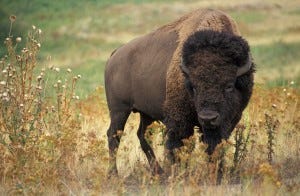We've all been Buffaloed

I found a really interesting article floating around the other day, and stopped to read it. It's not that I'm so much interested in the buffalo, as I was reminded of what people don't know about them. When I wrote Pixie Noir and sent it to beta readers, one of them wrote back a note about how I had made either a typo or a research mistake. Buffalo, or bison, were not found in Alaska. Had I meant to set my scene in Montana, or had I meant moose?
Very puzzled, it slowly dawned on me that as a granddaughter of homesteaders in the Delta Jct, AK, area, I had assumed that everyone knew about the bison herd that had been established in the area. It has grown enough that hunters are allowed to keep the herd down to a controlled amount, although hunting was not allowed in the early years when a family tale related to me involved the bison in a freezer and a game warden over to dinner. But that was a family friend, I'm sure.
The Alaska Department of Fish and Game, in an article about the herd, writes:
Although wood bison can still be found in Canada, they disappeared from Alaska about 100 years ago, likely because of hunters and changing environmental conditions. Plains bison were introduced to Alaska in 1928. The animals in the Delta Bison Herd are all descendents of 23 plains bison from Montana. The herd increased steadily throughout the ‘30s and ‘40s, and in 1950 a hunting season was established to stabilize the size of the Delta herd.
Emigration and transplants created additional herds at Copper River, Chitina River and near Farewell, and a few dozen permits are issued each year to hunt animals in these herds as well.
The Delta Junction Bison Range, a 90,000-acre tract of public land, was established in 1979 near Delta to ensure adequate winter range for the animals and to diminish damage caused by bison on adjacent farms. Bison spend fall and winter on the Delta Junction Bison Range and on private land in the area. During calving season, between late April and early June, they move a few dozen miles southwest to the gravel bars of the Delta River. But I'm rabbit-trailing. No doubt bouncing away from all those big hooves. The scene I had written involved high speed, the Alaska Highway, and a bison in the road. It didn't end well. But it also wasn't entirely fictional. I was recounting a story from my life, that happened to people I knew.
All that, to come back to this article.
Almost every schoolchild is taught that prior to the arrival of whites, Plains Indians lived in perfect harmony with nature as the ultimate socialist ecologists. According to the common tale, Indians had little private property-and certainly were not burdened by capitalism-and they hunted and killed only what they needed to live. Then Europeans arrived, and using the techniques of industrialized hunting, nearly exterminated the North American bison, also known as the buffalo. In the late 1800s, white hunters, such as William Frederick "Buffalo Bill" Cody, slaughtered the animals to meet market demand until the bison were nearly gone. Then, at just the right moment, government stepped in to save the buffalo by sealing them off at Yellowstone National Park.
It’s a convenient and easily told story, but it has left students, well, buffaloed. It has certainly caused the story of the buffalo to be misunderstood. Several new scholarly studies have emerged, though, and they universally provide a much more complex picture of the Great Plains in the late 1800s. Among other revisions, the works address the nature of Indian hunting, white motivations for killing the bison, and nonhuman factors affecting herd sizes. Most of all, though, they show that the ultimate savior of the buffalo was not the government, but the free market. Here, I will briefly review the findings insofar as they throw new light on the economics of the Indians both before and after the arrival of whites. I will look then at their assessment of the hunting efficiency of both Indians and whites. Finally, we will examine how private market forces, not government action, revived the buffalo herds.
Read more... I was fascinated. I hadn't read about the burning, but it didn't surprise me because I was aware of the cliff-hunts, and had seen pictures of some of the bluff areas known to be used. You don't need a big drop - and probably don't want one - to kill a buffalo.
The narrative is twisting history and anthropology away from reality, or at the least, the perception of reality. You aren't allowed even to question it, when new evidence is uncovered. Scholarship and curiosity are suppressed, and we are all the lesser for it.
Question something. Seek truth, not the crutches that consist of 'everyone knows' or 'teacher says.'



